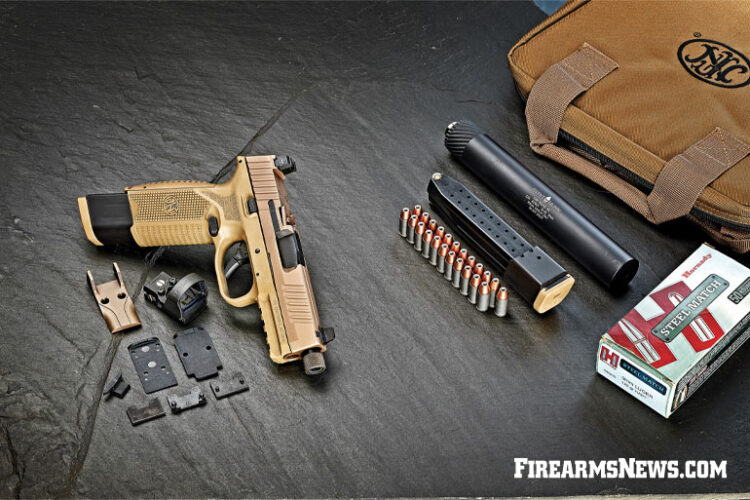
9mm pistols are hot again. The time of the .40 has come and gone, and the world wants 9mms all over again. For a dedicated .45 fan, this is not entirely good news, but hey, life can be like that. The world also is hot for suppressors, so if you expect to sell 9mms, you have to have at least one model that is ready to accept a suppressor. There is also a rising interest in red-dot sights, not just as competition items, but as EDC and tactical-use items. We are well into the 21st century, like it or not.
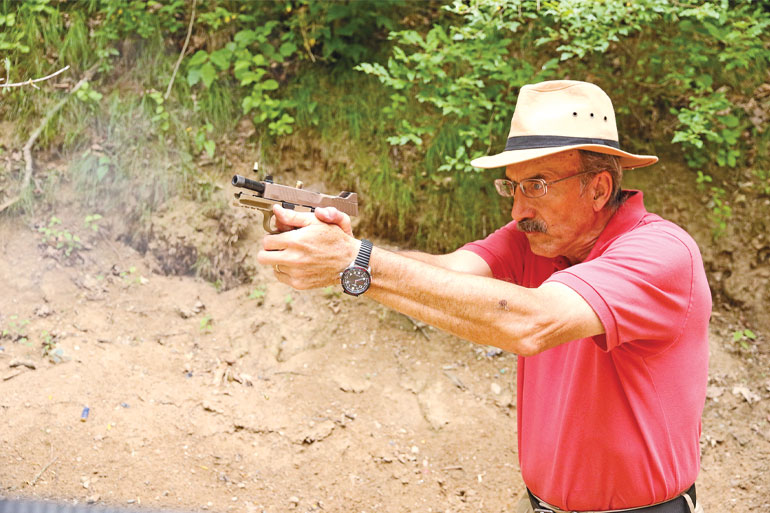
Well, FN went and took that into consideration, and then added more. And then more. And by the time it was done, it had a 9mm that I, a life-long .45 shooter, found myself warming to. I introduce to you the FN 509 Tactical.
The base pistol is the already excellent FN 509. We have here a striker-fired hi-cap 9mm pistol with a polymer frame, replaceable backstrap, and accessory rail on the dustcover. That is like saying a Detroit muscle car is a sedan with a big engine.
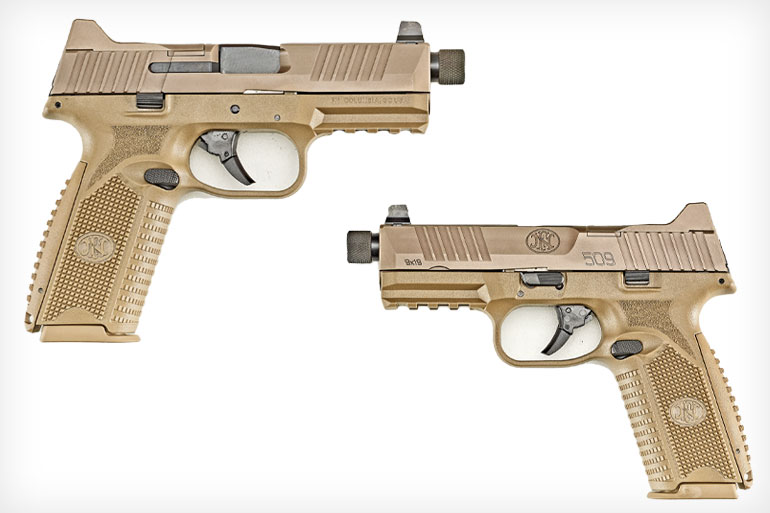
The 509 is the evolution of the FNS, the striker-fired pistol that FN had made before it (and still produces). FN took the excellent aspects of the FNS, and improved, well, pretty much everything about it.
The frame got a more aggressive non-slip texture. Not that there was anything wrong with what FN had done before, but in this regard, more is better, and too much is not enough. I’m old-school, and if a non-slip texture isn’t aggressive enough to make me feel as if my hands will be bleeding after a rigorous practice session, then it just isn’t non-slip enough. They kept the excellent replaceable backstrap, and you can change to the size you want, need or desire.
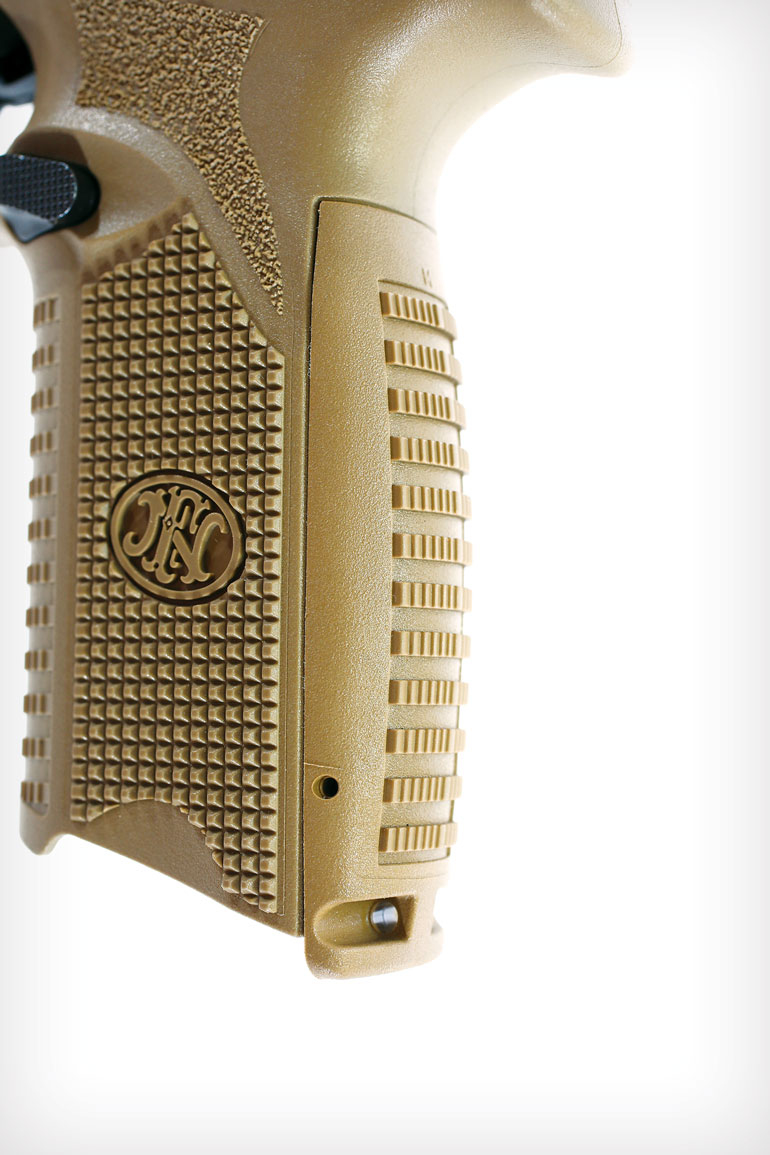
FN increased the size of the extractor from the FNS to the 509. Again, it wasn’t weak or failure-prone, but when it comes to extraction, I want a crowbar, not something less. The extractor also serves as a loaded chamber indicator, for them that feel the need for such.
FN kept the ambidextrous magazine catch. No button-swapping, no wondering which way the button needs to be pressed. Push either side in, and the magazine falls out. It kept the ambidextrous slide stop lever. Regardless of which side you favor, press the lever and the slide goes forward. It kept the grip angle, the undercut of the trigger guard at the frontstrap, the excellent trigger, and the accessory rail. It made the slide serrations more aggressive. It kept the passive firing pin/striker safety, which is moved out of the way only when your trigger finger presses the trigger. So, drop-safe it is.

The barrel is what you would expect from FN: a cold hammer-forged tube made of stainless steel, given a black finish, a one-turn-in-ten-inches twist, and with the feed ramp polished for reliable function. I have to say, in my testing, the 509 T never failed in that regard.
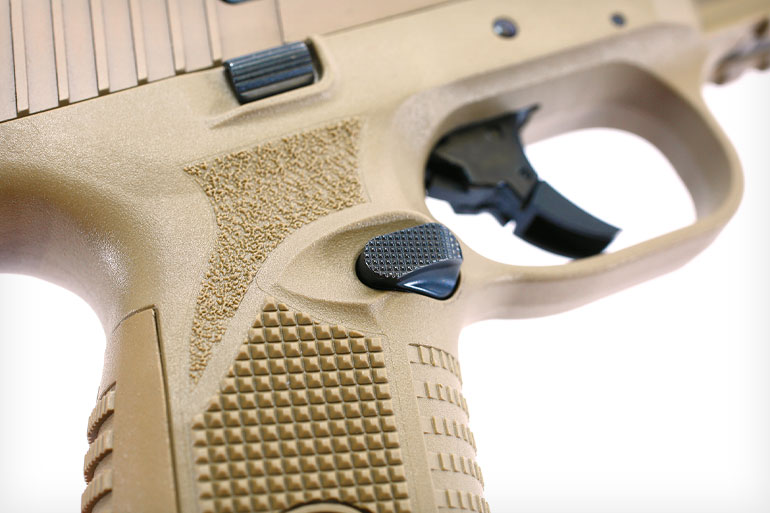
The frame is a polymer shell, with the chassis pinned into it, and the serial number of the pistol is laser-etched onto a plate inside of the accessory rail. The polymer formula FN uses is a secret, but this particular composition is stiff, and it does not exude a slick surface sheen in use or in the heat. The serial number location also tells us that the chassis pinned into the shell is not meant to be an interchangeable part, but goes with that shell onwards to the end of its use. I don’t have a problem with that, as I do not anticipate swapping polymer shells on the chassis willy-nilly.
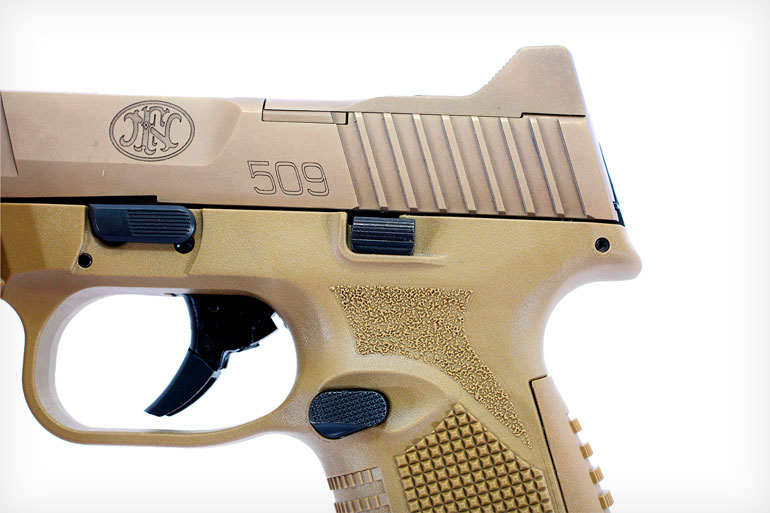
I had a chance to test the 509 when it first came out, and it was impressive. The fit, feel and the trigger were all very good, not just for a striker-fired pistol, but good in the overall comparison.
Why did FN do all this? The FNS was, is, after all, an excellent pistol. Simple: the Army finally admitted that pistols matter to the troops who actually have to shoot people, and the M9 had been serving for a long time. They wanted more, and they wanted a lot the M9 wasn’t able to do. So, they, after many fits and starts, got around to the Modular Handgun System competition. The 509 was the FN entry to that competition, and despite not winning, the result was a most-excellent pistol that we can all buy and use. One could say that FN didn’t win the competition, but we all won because of the competition, and that is a good thing.
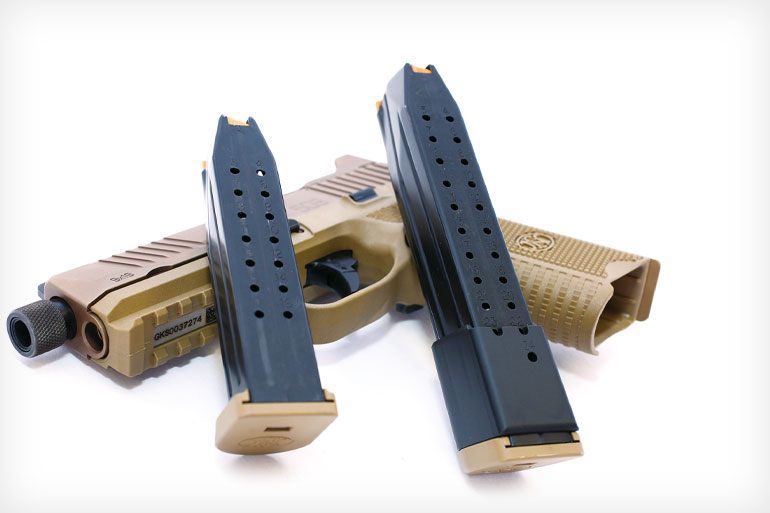
So, FN upgraded the FNS into the 509 and rolled it out to us a bit more than a year ago, and did a cracking good job of it. But the 509 isn’t exactly new, not in this day and age of “what have you done for me lately?” The 509 Tactical, on the other hand, is.
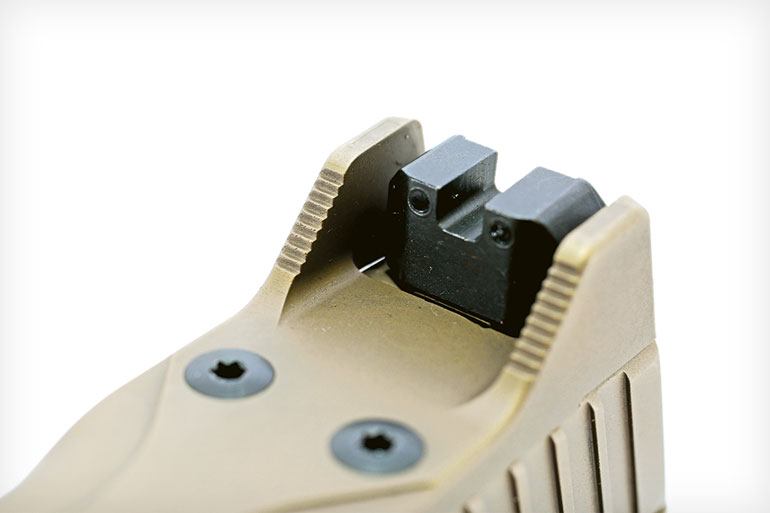
The color. The slide is finished in a close-to-sand or coyote, or whatever we’re calling the current “We need this for the desert” color that is tactically cool and essential. Not to make light of it, because in the 21st century, anything but black is an improvement. The finish is a process known as physical vapor deposition, or PVD for short. This involves placing the (in this case a slide) parts in a vacuum chamber and pumping the air out. Once the parts are clean (not just scrubbed, but clean at a level that would make your grandmother proud), the process operators apply an electrical charge to the slide. The coating material is vaporized, and its charge is the opposite of that of the slide. The coating is attracted to the slide and bonds in an even, exactingly thin layer. It has the added benefit of not creating edge buildup as electroplating does. What is the material they deposit on the slide? This is something you’ll have to get used to, but FN isn’t saying.
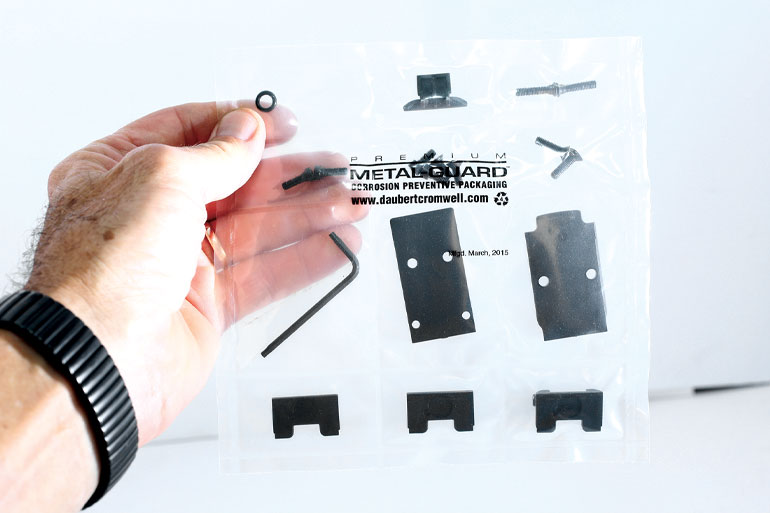
I asked FN about the color. “We chose the slide and frame colors because they compliment each other well. There is no way to perfectly match the colors unless we paint them. We chose not to use Cerakote or any other paint process.”
I asked about the finish of the barrel. I mean, it is a stainless tube, right? So how do they make it black? Well, FN isn’t divulging that detail, either. I can’t say I blame them. I mean, if I found a durable, non-dimensional coating for stainless barrels, or slides, or other parts, I wouldn’t be shouting the technical details from the rooftops either. Ditto on the coating for the magazine tubes. They are not painted, they have a durable finish, and it isn’t something they will tell me.
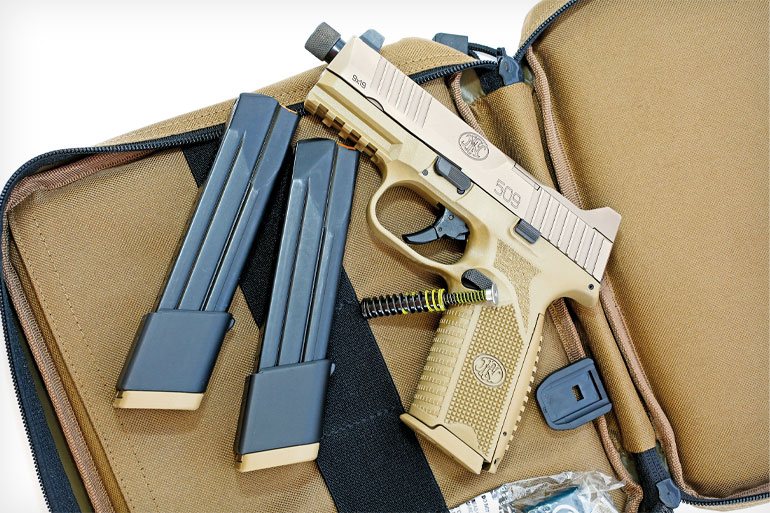
Speaking of magazines, the regular 509 comes with 17-round magazines. The 509 Tactical comes with one 17-round magazine and a pair of 24-round magazines. Oh my. And best of all, the big-stick tactical magazine will be something you can buy without having to buy the 509 T. Of course, you should buy the 509 T anyway. But if you already have a 509, and want more ammo capacity, then you can have more ammo capacity. The standard magazine, loaded and ready-to-go in the pistol, plus the two spares, totals 66 rounds of 9mm goodness for emergency use. If that wasn’t enough, you should have started with an airstrike.
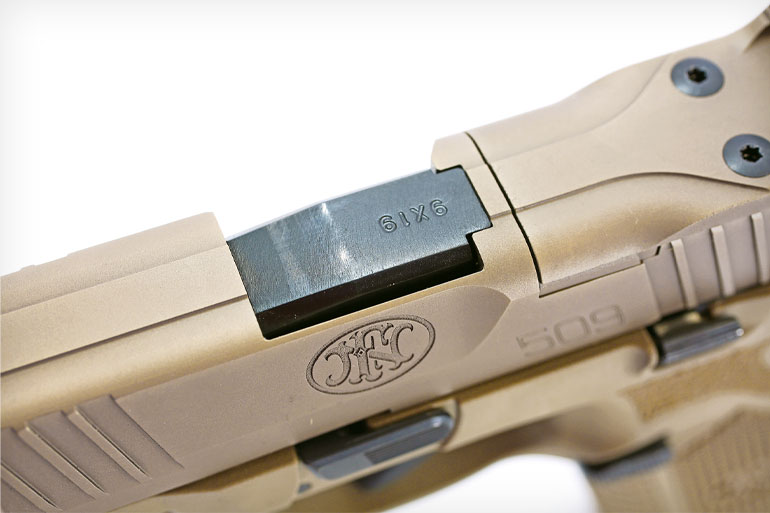
The big change on the 509 Tactical comes on the slide and barrel. Specifically, the barrel is extended, and the slide is readily fitted with a red-dot sight.
The standard four-inch barrel on the 509 is lengthened to 4.5 inches for the suppressor mount. The threads are standard ½-28 pitch, and right-handed (none of this Euro-metric-left-handed funny business for American guns, thank you very much) and the barrel comes equipped with a thread protector. This means that when it comes time to remove the barrel for cleaning, you have to unscrew the thread protector, but that is a small price. Needless to say, you’ll have to remove the suppressor to remove the barrel for cleaning, also. For the FN 509 Tactical testing, I managed to lay hands on a new suppressor, from a relatively new maker, Silent Legion.
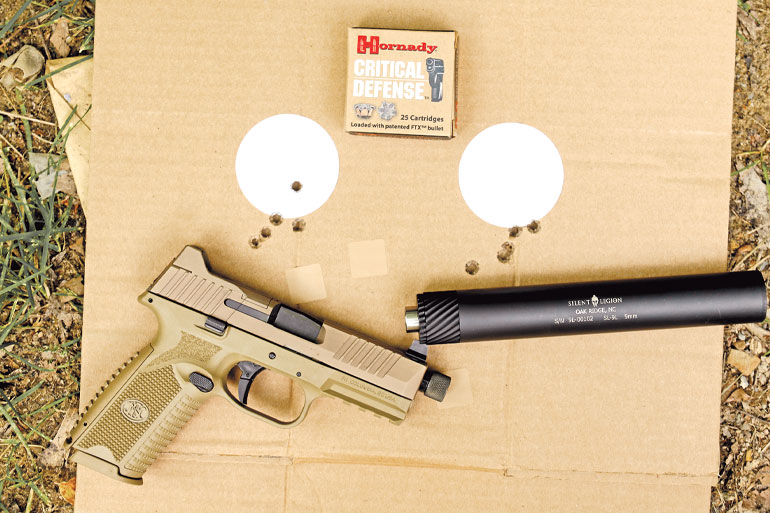
The slide gets machined for a red dot mounting location. What FN has done, instead of making it simply a plate you lift off, is make the plate with protective wings for the rear sight. When the plate is there, and you have just irons, the wings on the plate protect the rear sight. You’d need a ball-peen hammer to damage the rear sight with the mounting plate in place.
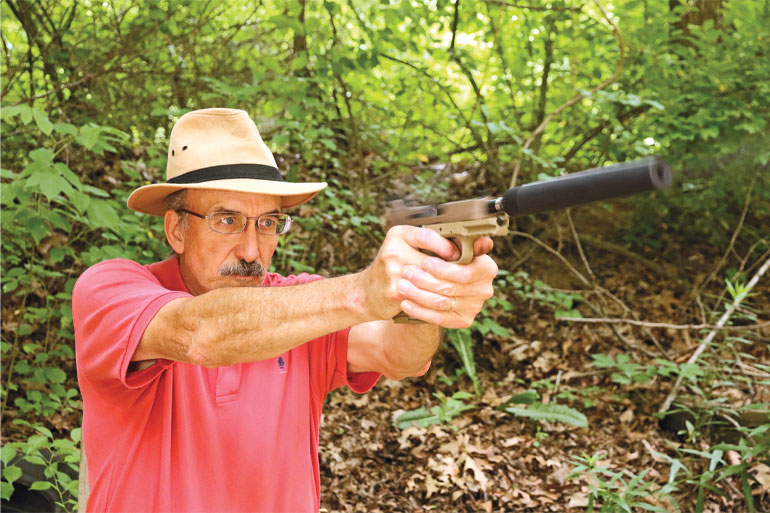
The sights are tall enough to be used over the suppressor you will be mounting to the 509 T. They are also three-dot tritium night sights.
To mount a red-dot sight, you unscrew the two bolts on the top of the plate, and you select the appropriate adapter or adapters to fit your particular red-dot sight to the 509 T. Worried that FN won’t have an adapter for your RDS? The owner’s manual that came with the 509 T (yes, I read the manual, that’s my job) lists nine RDS models that will fit. There are more RDS choices than that, but most of them will use one of the common patterns and dimensions for their attachment. If your no-name knockoff says it uses the “XYZ” pattern for attachment, then you’re set if that is on the list from FN. Looking over the list, really, if you have an RDS that won’t fit, you have wandered far off the path of red-dot sighting systems. And you can’t expect FN to make the slide adaptable to fit every model of red-dot sight ever made, or ever to be made. Check the list in your manual for the plate, insert, and screw set that will properly bolt yours on. Attach everything. Interestingly, FN informs us that we do not need to use a threadlocking compound on the screws. They are self-locking, and if you use a threadlocking compound, you may not be able to take the sight off later.

Someone is still going to do it, and I look forward to a future article titled, “How to Remove the RDS You Permanently Attached to Your FN 509 Tactical Because You Didn’t Believe the Manual.”
Depending on which RDS you have, you may or may not still be able to see your sights through the RDS. The adapter plates let you bolt on the RDS, but the main one, removed, also takes the rear sight protective wings with it. Darn. It would have been nice if it could have been managed to keep the wings, but looking at the slide, I suspect FN attempts at doing that resulted in a pistol far too bulky to be suitable.
The pistol comes in a zippered FN case in desert tan, with three magazines (one 17 rounds, two 24 rounds), lock, adapter plate and screw set, and owner’s manual.
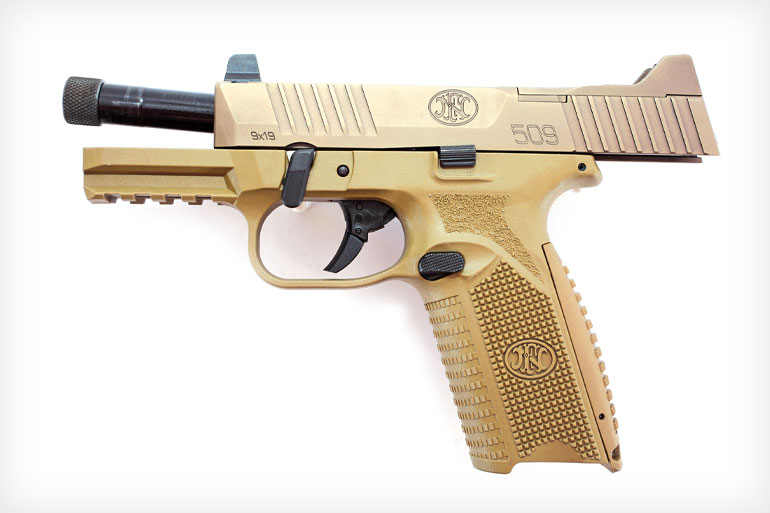
I would have loved to have unbolted the plate, and having pawed through my drawer of red-dot optics, tried each and everyone one I had on hand on the 509 T.
However, this was not to be. You see, we were the first to have the 509 Tactical free from the factory, and it came to me directly from the factory for a day of shooting, before I had to send it on, in its grubby state, to the studio photography for the luv shots. That meant I had to do the accuracy and chrono work, the testing with a suppressor, and whatever fun I could manage plinking with it in one day, and get it on its way. (Yes, sometimes this job is soooo hard.)
What I found was that I liked the FN 509 T. A lot. The trigger is very nice. The spec sheet promises a 5.5- to 7.5-pound trigger, which is under-promising and over-delivering. The trigger is very nice. Just like the previous 509 I tested, the trigger was surprising for a striker-fired pistol. The feel was clean. Once I took up the slack, I could apply pressure until the striker struck.
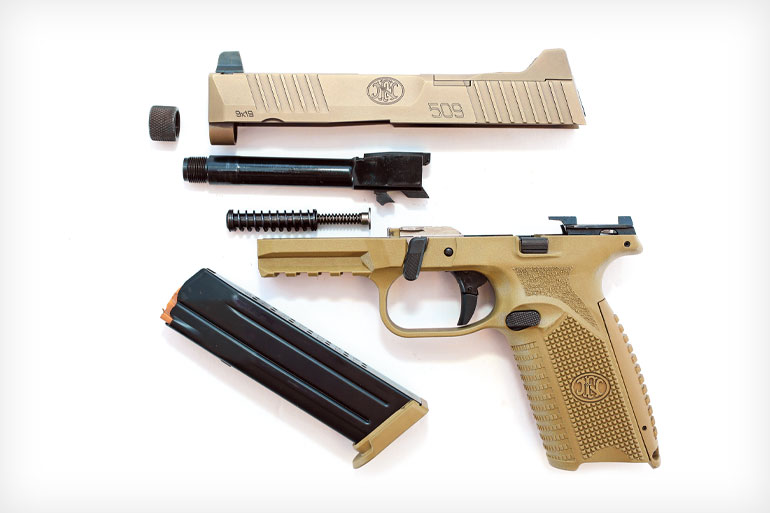
It wasn’t crunchy, gritty, spongy or any of the other “normal” attributes of a striker-fired pistol trigger. And, breaking at the bottom end of the range, at 5.5 pounds, it felt lighter than the typical, traditional “5.5-pound” trigger pull of a striker-fired pistol. Trigger pull weight or feel is not going to be a hindrance to good shooting.
The grip shape kept recoil to a comfortable level. Back when I tested the standard 509, I used a wider range of ammo, and then, even the snappiest loads were no big deal in regards to recoil. With the 509 T, I kept the loads to normal velocity normal weight and subsonics. Hey, you’re going to be putting a suppressor on a pistol, you use subsonic ammo, not +P or +P+ loads, right?
Some will complain that the bore axis on the 509 T, like the 509, is higher than on other pistols. Like people who want a short trigger re-set, I think many make too much of it. Sure, a higher bore axis is going to mean a bit more leverage for the pistol in recoil, but it’s a 9mm, for gosh sakes. Front sights rise in recoil, and they come back down again. Unless you are a USPSA Grandmaster, bore axis is a non-issue.
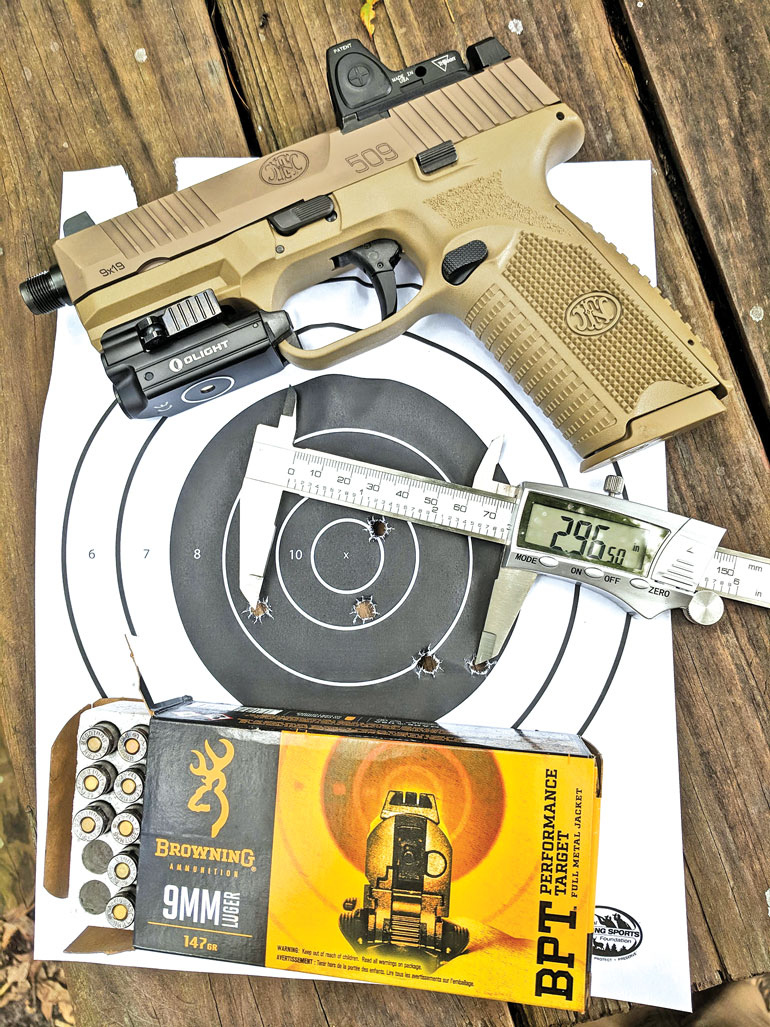
The match barrel, besides being cold-hammer forged, is made with Enfield rifling. That means it will be fine with lead bullet reloads. Now, you won’t want to be pumping those down a suppressor (even though a pistol-caliber suppressor can be taken apart and cleaned, that doesn’t mean you want to make the job even more of a hassle than it already is), but there is nothing less expensive than lead-bullet reloads for practice. Well, short of going right to a .22 LR version of things, but that’s not a choice here. Unlike some polymer pistols with polygonal barrels, the FN 509 Tactical won’t make you pay for trying to get more practice at less cost.
Accuracy? Really, you need to ask? I shot the 509 Tactical both with and without the suppressor, for accuracy and chronograph data, and the process was as painless and gratifying as expected. Once I had done the group shooting and chrono work, I ran the plate rack a few times (OK, a few dozen times) and then went over to the rifle range to work over the gongs there. A hold on the top edge of the gong and a clean break produced a “klink” in return for as often as I cared to pay attention to the basics of marksmanship.
It was even more fun when I did it with the Silent Legion suppressor, as I could shoot without hearing protection and thus hear the feedback more clearly.
So, do you need this pistol? That is part of a larger existential question I cannot answer for you. What you need depends on where you are, what you do, and the problems that you face. Will you want this pistol? Oh, yes. The price may seem a bit off-putting, but the jump in price over the standard 509 (which is an excellent pistol on its own) is reflective of the extras you get. And worth it. The MSRP of the 509 Tactical is some $400 more than the standard pistol.
Were you to have a standard 509, and wanting to make it into your own version of the 509 Tactical, you could not do it for less than $400. You could do it for that much. An extended, threaded match barrel is going to run you half of that much cash, and the machining for the RDSD installation will cost you the other half. And you still won’t have the PVD finish on the slide, nor the desert tan frame and slide colors.
Converting your existing 509 (or some other polymer-framed striker-fired pistol) into a clone of the 509 Tactical is going to end up costing you more than the MSRP of the 509 Tactical.
So, save yourself the extra cost, the time and the hassle. Get the real deal, the 509 Tactical.
Takedown
The usual process. Unload the pistol. Lock the slide to the rear. Rotate the disassembly lever until it is pointed straight down. Unscrew the threads protector. Ease the slide forward. Once it is to the fully forward position, dry fire it. Then, remove the slide from the frame. Pull the captured recoil spring assembly out of the slide, followed by the barrel. Screw, lube, reassemble.
FN 509 Tactical Specs
- Type: Striker-fired semi-auto
- Caliber: 9mm Parabellum
- Capacity: 17+1 (24 round magazines supplied)
- Barrel: 4.5”
- Overall length: 7.75″
- Width: 1.625″
- Height: 5.75″
- Weight: 37oz.
- Construction: Steel slide, polymer frame
- Finish: PVD on slide and barrel
- Grips: N/A
- Sights: Three-dot tritium, fixed rear
- Trigger: 5.5 lbs.
- Price: $1,049
FN 509 Tactical Accuracy and Chrono Results



